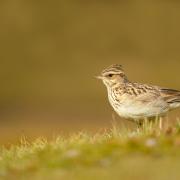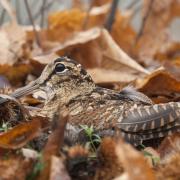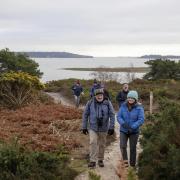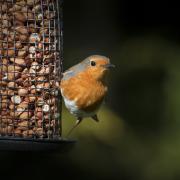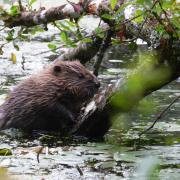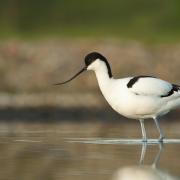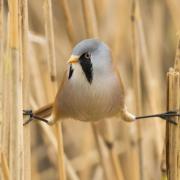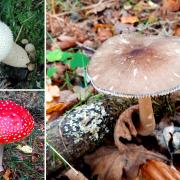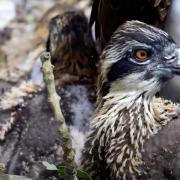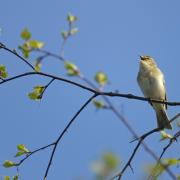The winter is perfect for novice twitchers to spot some of the rare species that come Dorset every year. Here is our definitive guide of what to watch, when and where

Winter maybe the season for snuggling indoors by the fire, but if you wrap up and head for the outdoors you will be well rewarded for your efforts as Nicky Hoar, Dorset Wildlife Trust (DWT) conservation officer, explains: “The winter months are a very exciting time for birdwatching, it really is the best time year for it. If you go out on a really cold, still day you will see a huge variety of wildfowl and waders that have come to Dorset for the winter. It’s a fantastic sight.”
Nicky recommends Poole Harbour and Brownsea Island, especially if you are new to birdwatching. “Wildfowl and waders are great for beginners because they’re easy to identify and you can get up close to them in the hides on Brownsea lagoon.” She also suggests the Fine Foundation Chesil Beach Centre as another hot spot. “Weymouth, Portland and the Fleet make a great day out for birding. The Fleet is home to huge numbers of Brent geese. For me the sound of geese is the sound of winter. I love listening to the Brents ‘chat’ to each other.”
If you want to spot a rare warbler then head for the heath. “Upton Heath has really rare heathland birds all year round – including the Dartford warbler. This tiny warbler, one of only two warbler species that stay in the UK year round, survives in what looks like a bleak and barren landscape,” says Nicky. “And, if you’re really lucky, you might also see a hen harrier or a merlin. Keep your eyes peeled for redwings and fieldfares visiting from Scandinavia.”
However you don’t need to go far to enjoy a spot of birdwatching - don’t overlook places that are closer to home, these are often surprisingly urban. “Supermarket car parks are one of best places to see waxwings,” says Nicky. “Supermarkets plant attractive trees with berries that the birds love to feast on, especially in very cold weather.”
While a good bird identification book is all you need to get started, Nicky also suggests going on a guided walk or birdwatching event. “It really helps to be given some pointers from an experienced birdwatcher. Binoculars are also useful, but not vital. In fact you can do birdwatching anywhere at anytime – I do!”
---------------------------------------------------------
Nicky’s top winter birds and where to see them
At Chesil... I would always expect to see the ringed plover and the dunlin. Both are little birds and really cute – they come in to Chesil for the winter and a few ringed plover also breed here.
At Brownsea... It’s got to be the avocet and the black-tailed godwit. Brownsea holds the record for largest flock of avocet ever seen in the UK – over 1,300 birds. The Brownsea lagoon is internationally important for numbers of black-tailed godwit. Look out for spoonbills – at the moment there are 26 in Poole Harbour, they move between Brownsea and other sites. Brownsea Island is open at weekends from 9 February – 16 March (10am-4pm) and from Monday to Sunday from 23 March – 2 November (10am-5pm). For more information about Dorset Wildlife Trusts members guided day trips visit dorsetwildlifetrust.org.uk/events. Departure on the National Trust boat from Sandbanks. Booking essential 01202 707744.
At Poole & Portland... Keep your eyes peeled for the elusive bittern. This beautifully camouflaged member of the heron family now comes into Dorset for the winter; look for them near reedbeds. Also look for the great northern diver – you’ll find them in Poole Harbour and Portland Harbour, they’re amazing-looking birds. Finally keep your eyes and ears open for Brent geese!
----------------------------------------------------------------
Top birdwatching spots in and around Poole
From November to March up to 40,000 winter waders and the UK’s largest wintering avocet flock in the UK take advantage of Poole Harbour’s unique environment. Poole’s Bird Boats offer specially tailored trips with experts from the RSPB to guide you (discount for RSPB members). For more information visit rspb.org.uk/datewithnature or call Brownsea Island Ferries on 01929 462383.
You don’t have to get out on the water to spot wildlife, armed with a pair of binoculars Holes Bay, Shore Road and Harbourside Park in Poole are great birdwatching sites. In January and February look out for one of Nature’s most spectacular aerial displays as starlings flocking over Sterte Esplanade, Poole at dusk.
The RSPB Reserve at Arne also provides a superb alternative view of the harbour and has the perfect habitat for marsh and hen harriers which patrol the reedbeds. Join one of the free regular Wednesday walks in the company of an RSPB guide. To discover more visit rspb.org.uk/arne.
Set in more than 100 acres of woodland and parkland on the northernmost reaches of Poole Harbour, Upton Country Park offers views towards Poole town across the harbour, the mudflats and marshes. Regular guided RSPB Birds, Binoculars & Biscuits walks will help you hone your skills and spot winter migrants. Look out for winter visitors such as redwing and fieldfare feasting on the park’s plentiful berries and fruit. For more details about guided walks visit uptoncountrypark.com.
Whether a novice or expert, make the most of the experience with monthly RSPB guided walks. With a maximum of 20-30 people, the walks cover different locations and habitat depending on the season. More details can be found at birdsofpooleharbour.co.uk. If you can’t get down to the coast then you can still birdwatch via the Brownsea Lagoon Webcam. This live feed captures all the action from the Dorset Wildlife Trust’s reserve on Brownsea Island. Go to birdsofpooleharbour.co.uk and click on the live webcam feed.
For more details about local wildlife events visit pooletourism.com/wings----------------------------------------------------------------
Reserve of the month
Even on a blustery winter day, the sight of wheeling sea birds and winter waders on the shore and the Fleet viewed from the Fine Foundation Chesil Beach Centre is always an inspiring sight. The strategically located Visitors’ Centre, which was formally opened by Lord Coe last summer, overlooks the sweeping 17 miles of shingle which makes up Chesil Beach. The recently renovated Centre is the result of a fruitful partnership between DWT, the Weymouth and Portland Borough Council, the Jurassic Coast Team and the Chesil Bank and Fleet Nature Reserve. Now managed by DWT with the help of local volunteers it’s the perfect spot for wildlife enthusiasts as well as offering superb views of the spectacular scenery of this celebrated stretch of Jurassic Coast.
Inside the Centre there is an informative exhibition about the beach and its wildlife, with interactive displays, underwater camera, and a telescope to keep a check on the always-active bird life.
Outside a hundred metre long wooden boardwalk traverses a stretch of brackish water known as the Fleet, England’s largest saline lagoon. The boardwalk, which links the beach at its Portland end, offers great opportunities to watch birds and other wildlife from a great vantage position.
At this time of year keep an eye out for some of the Fleet’s winter visitors including red breasted mergansers, turnstones, ringed plover and oyster catchers. You may also see some Brent geese before they return to their Arctic breeding grounds. The sharp-eyed may spot the resident short-eared owl patrolling the vegetation behind the Centre or even a hare on the beach, feeding on some of the succulent vegetation that grows there. For more information about the Chesil Beach nature reserve contact Emily Brown on 01305 206191 or visit dorsetwildlifetrust.org.uk. Giles Harbottle








